The privileged position of Texas makes it one of the states with the most butterflies in the US.
Warm weather and proximity to Mexico mean Texas is home both to North American and Central American butterfly species.
Texas is also home to unique species that are only found here. Furthermore, it’s also the witness to several migrating species that use it either as a destination or as a route to migrate from cold climates.
The extreme Southern parts of Texas and the Eastern parts of the state tend to be the most populated areas.
Most migratory butterflies escaping cold winters in the North establish themselves in Southern parts of the state.
Some species of butterflies in Texas only migrate within the state. Butterflies that don’t like overcrowding may sometimes migrate to other regions of Texas.
Both small and large butterflies are found in Texas. Some of the smaller species here have a wingspan of just over 1 inch.
Large butterflies in Texas have a wingspan of more than 5 inches, as in the case of the Eastern Giant Swallowtail.
Nectar is among the preferred food sources for Texas butterflies. Milkweeds and herbs such as spearmint are common nectar sources.
A significant percentage of Texas species also feed on dung and mud. They extract nutrients as food.
Host species for caterpillars include trees and shrubs. Some of the caterpillars of Texas butterflies are also minor pests of alfalfa, cabbage, cauliflower, and broccoli.
Here are the most common species you can encounter in Texas.
Table of Contents
1. Monarch

Monarch butterflies (Danaus plexippus) are the state insect of Texas among other states. These large colorful butterflies are common across North America.
Monarchs grow to a maximum wingspan of 4 inches and they are characterized by orange and black wing colors.
A darker orange nuance is specific to males while the females are closer to yellow than to orange as a base wing color.
Black veins and black wide margins are specific to these butterflies. Monarch butterflies are among the most common species with wide black margins.
The margins of the wings are further decorated with small white marks.
Some Monarch butterflies migrate while others don’t. Migration is more specific to species in Central and Northern United States.
Adults of the species have a varied nectar diet compared to the larvae which mostly feed on milkweeds.
Adults feed on all types of nectar sources such as those from horseweed, wild carrots, or hemp.
2. Gulf Fritillary

These species of butterflies (Dione vanillae) are also highly common in many areas of Texas.
Butterflies of this genus are seen in the state until they decide to migrate North. You can identify the species easily since it has coloring similar to Monarchs.
Gulf Fritillary butterflies also have orange and black colors, just like Monarchs.
These butterflies have a base orange color on the wings and they have black veins and black borders along the wings.
White marks are seen along the wings of the species but not in the form of dots as on the margins of Monarch wings.
White marks are further visible on the upper side of the forewings.
The caterpillars of the species have chewing mouthparts. These later become sucking and piercing mouthparts the butterfly uses to get nectar from various species.
Passion vines are among the favorite nectar sources for these butterflies. Further South, Gulf Fritillaries are a common sight on Mexican sunflowers.
3. Queen

Queen butterflies (Danaus gilippus) bear some resemblance to Monarchs and Gulf Fritillary butterflies as they’re also mostly orange and black with white marks on the wings.
In the case of Queen butterflies, the darker orange color is specific to females rather than males.
Wide black borders are seen along the wings which are further decorated with white spots.
Related to Monarchs, Queen butterflies have a similar size and similar coloring.
There’s no resemblance between Queen adults and Queen caterpillars. The caterpillars of the species have alternating black and white bands with yellow dots or interrupted yellow lines.
The diet of the adult Queen is considerably different from the diet of its caterpillar.
Adults feed on the nectar of various plants but they also frequently consume animal dung and rotting fruit.
Queen butterflies have also been seen consuming rotting leaves.
While milkweed remains a common source of nectar for the species, the wider choices of food make for easy distinction between Queen butterflies and related Monarch butterflies.
4. Gray Hairstreak

With a wingspan of up to 32mm, Gray Hairstreaks (Strymon melinus) are some of the most common butterflies of Texas.
They come in a gray or purple-blue color with orange spots on the lower hindwings depending on their gender.
Most sections of the wings are gray, as is the ventral side of the wings.
Black and orange spots and marks are also visible on the ventral wings of Gray Hairstreaks.
The caterpillars of this genus may do more harm than adults by eating fruit and the leaves of various legumes.
While they can be seen on other host plants, it seems most caterpillars of the species prefer legumes as host plants.
Typical of tropical forests, these butterflies are mostly seen in Southern Texas as well as further South into Mexico.
These butterflies are even adapted to living at high elevations.
5. Pipevine Swallowtail

Pipevine Swallowtails (Battus philenor) are common around Texas as well as in Other Southeastern states.
These butterflies have a dark color both dorsally and ventrally and they stand out with their unique patterns on the wings as well.
Black is the dominant dorsal color for the species. Their forewings are black while the lower part of the hindwings is blue.
The ventral side of the species is also similar but with further decoration. White dots are seen across its forewings.
Orange and white dots are also seen on the entire ventral surface of its hindwings.
These orange dots are flanked by black borders, assumingly to act as warning signs for predators.
Male pipevine swallowtails spend most hours of the day either feeding or looking for a mate.
These males have semi-social lives as they are known to eat nectar alone but also consume nutrients from mud in groups.
It’s believed this puddling behavior is encouraged by other males.
The more Pipevine Swallowtails feed from mud, the more likely other males of the species are to join the group.
Females don’t feed on mud nutrients as they prefer nectar.
6. Common Buckeye
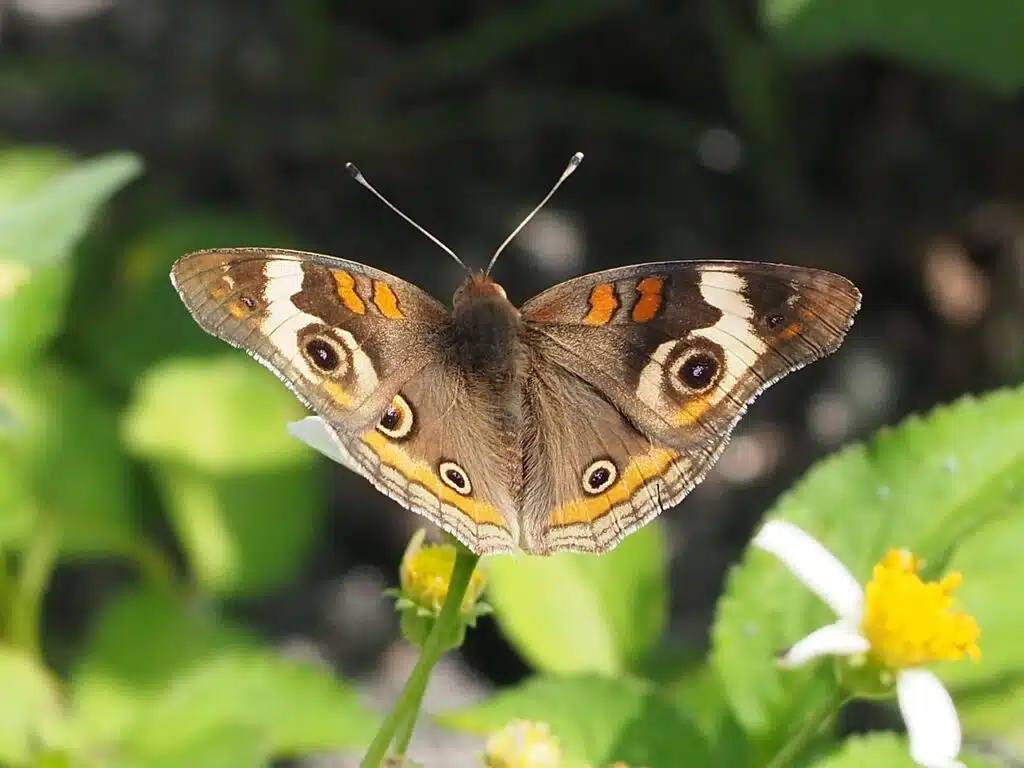
Common Buckeyes (Junonia coenia) are seen in Texas during the winter months. They are a migratory butterfly species that move back North once the warmer spring days arrive.
This species cannot tolerate the cold winters in the North so it has to move to the South for warmth.
You can identify the Common Buckeye by its mostly brown color with eyespots across the wings.
Butterflies of this genus have multiple eyespots that decorate the wings. These eyespots are also mostly brown with black and white as additional colors.
Common Buckeyes also have a minor pollination role. The species pollinates a range of flowers, particularly yellow flowers.
These butterflies are known to prefer the nectar of various yellow flowers in their early life.
Butterflies of this genus migrate together even if they’re not particularly social otherwise.
This individualism is a characteristic of the Common Buckeye caterpillar more than of the adult.
Caterpillars of this genus live on their own or in remote areas of a host plant rather than sharing the same space with another caterpillar.
7. Fiery Skipper

A common sight across Texas, the Fiery Skipper (Hylephila phyleus) is typically not a good sign as this is a pest of different types of turf grasses.
Adults and caterpillars feed on grasses alike.
The species is also different from others because it can hold its wings in a triangle shape. Its forewings can be folded vertically while its hindwings sit horizontally.
Some of the theories behind the positioning of its wings are based on the idea that the butterfly needs to efficiently absorb direct warmth and light from the sun.
Apart from its unusual positioning of the wings, the Fiery Skipper may be identified by its brown and yellow coloring.
Almost the entire surface of the wings is yellow while the margins are dark brown.
This dual color makes the species resemble some yellow and brown flowers in the state.
A light brown color is specific to the body of the species.
8. Red Admiral

Red Admirals (Vanessa atalanta) are some of the most common migratory butterflies in Texas. This species moved to Southern states as stinging nettle appears as this is its favorite plant for food.
Red Admirals move to Texas and other Southern states from the North.
This is a time when all butterflies move together. They fly at a very high altitude so that they get the benefit of wind for portability which gets them to the destination with less effort.
Known for their large black wings, Red Admirals are some of the species with red coloring and white bands across the wings as well.
The contrasting color of the species makes it unique in Texas.
Red Admirals are some of the most characterful species in the state. Butterflies of this genus are known for their territorial nature.
Male Red Admirals fight for territory control which is resource control.
The male Red Admiral is interested in defending stinging nettle and similar specie as food for itself and females.
As a reward, the female Red Admiral only mates with the males that have the best territory control.
Butterflies of this genus begin migrating back to the North in a new generation.
The innate need for migration is characteristic of the species as the same generation doesn’t make the flight back to Northern territories.
Further Reading:
9. Black Swallowtail

The Black Swallowtail (Papilio polyxenes) is one of the fastest large butterflies in Texas. Its high flying speed allows it to escape many types of predators.
This species might also be known as the Parsley butterfly. Black Swallowtail caterpillars feed on parsley.
Sexual dimorphism is specific between males and females. The female is larger than the male.
Both males and females are predominantly black with short black tails.
Males might take on the colors of the females at times, mainly for higher courting success.
Most males have black wings with a few rows of yellow spots along the hindwings.
Further colored marks are seen on the lower hindwings which show orange and blue marks.
Females of the species also have a black body but with fewer yellow marks.
You can also differentiate males from females by the clarity of the yellow dots which seem more faded in females.
The lower part of the hindwings also shows a considerably larger blue area as opposed to the small blue spots on the lower male hindwings.
Females also have smaller orange marks on the lower hindwings.
The body of the male and the female Black Swallowtail is mostly black with 2 rows of small yellow dots along the sides.
10. Variegated Fritillary

The checkered Variegated Fritillary (Euptoieta claudia) is an orange and black species that are sometimes confused with the Mexican Fritillary.
This species has an orange color with a darker nuance compared to its Mexican neighbor.
Its black checkered pattern is completed by black eyespots along the wing margins. This species has black wing margins and a mostly black body.
In Texas, the Variegated Fritillary is seen in up to 3 broods per year. Some of these broods might be the result of migration.
With a wingspan of up to 2.2 inches, the species is found both in areas with dense vegetation as well as in open areas.
The Variegated Fritillary is among the species that only consume flower nectar for food.
As a result, you might find this species in certain areas of the state where its favorite flowers grow.
Dogbane and milkweed are among their favorites. Asters, fleabane, alfalfa, and ironweed are secondary choices for nectar.
You may also see this species on plants that grow in gardens such as stonecrops.
11. Pearl Crescent
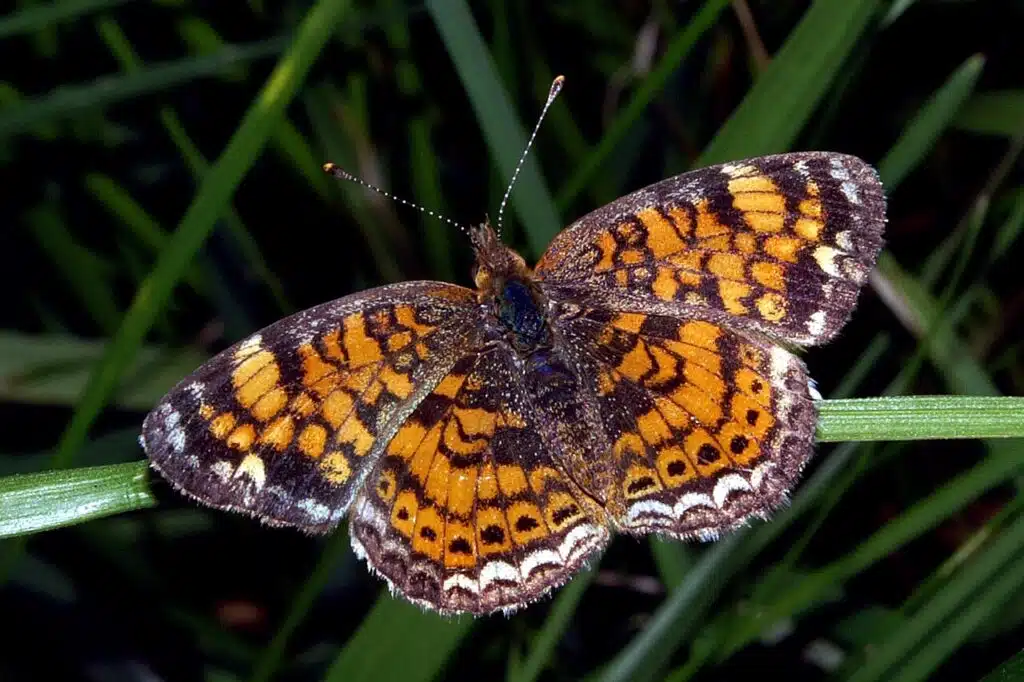
Pearl Crescents (Phyciodes tharos) have a high presence in Texas and across Western North America. Males of the species have more pronounced coloring than the females, even if they’re smaller (with a wingspan of up to 32mm).
Orange, black, and white are the colors of the butterfly. Orange background with a slight yellow section on the upper wings dominates the forewings and the hindwings.
A checkered pattern and black visible veins decorate these orange wings.
The body of the butterfly is black as are the margins of its wings. As in other orange species, Pearl Crescent butterflies have white marks across the black margins.
If Variegated Fritillary butterflies live in woodlands and open areas, Pearl Crescents prefer open areas.
You might still see them in woodlands, but mainly in woodlands openings. This species feeds on common milkweeds such as swamp milkweed as well as on shepherd’s needle.
Asters are common nectar sources for Pearl Crescents as well.
This species is seen up until late November in many states.
Pearl Crescents live throughout the year in Texas as well as in Mexico.
12. American Snout

The American Snout butterfly (Libytheana carinenta) is a native species with an elongated snout. This snout is often used by the species to hang undetected from a tree branch.
It has an orange and dark brown color with a few white spots as decoration.
The underside of its wings looks exactly like dry tree leaves which makes it hard to detect on its host trees.
American Snout butterflies are most common in Southern Texas where they can be either a sedentary or a migratory species.
These butterflies don’t migrate every year. They only migrate in extreme drought years.
Oftentimes these butterflies fly to Northern or Central parts of Texas from the South.
This migration is not seen as a good sign for local trees and plants.
However, American Snout butterflies will try to stay in the Southern parts of the state as this is where they find their host tree, the spiny hackberry.
In case of extreme drought, these butterflies can become less active and even consider hibernation.
Heavy rain across the state prompts the spiny hackberry to grow new leaves and this is believed to also attract the American Snout butterfly.
The species typically migrate in the summer or early fall.
Its migration preferences and period vary in nearby states.
13. American Lady
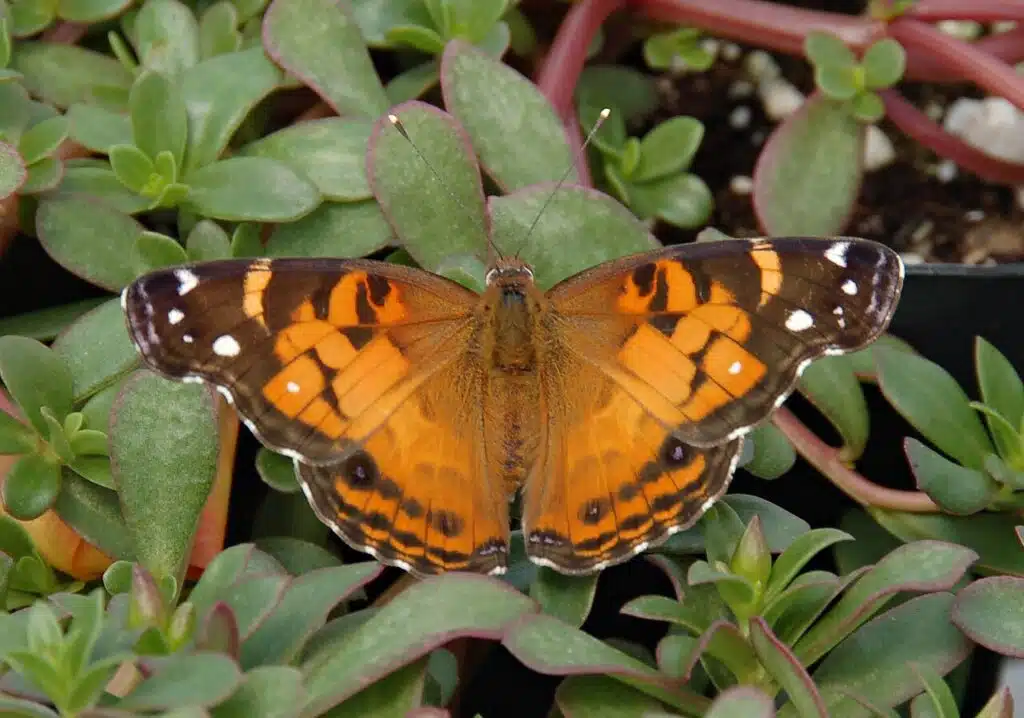
American Lady butterflies (Vanessa virginiensis) are some of the most common migratory species in Southern states such as Texas and Florida.
These butterflies come to overwinter in Texas. They make their way from the Northern states and remain in Texas until the beginning of the spring.
You can identify the species by its orange and black dorsal color combination. Black wing margins and orange-dominating base color are specific to the American Lady butterfly.
Black and white eyespots are specific to this species with a similar pattern in different colors being seen ventrally.
The ventral color of the species is a combination of brown, gray, white, blue, black, and dark brown.
Larger eyespots are visible on the ventral side of the wings. These eyespots are black with a blue center and bordered by white and black circles.
American Lady is also a species that’s known to build a net-like structure over host plants such as caterpillars.
You can identify the caterpillars of this species are seen on everlasting herbs.
14. Clouded Skipper
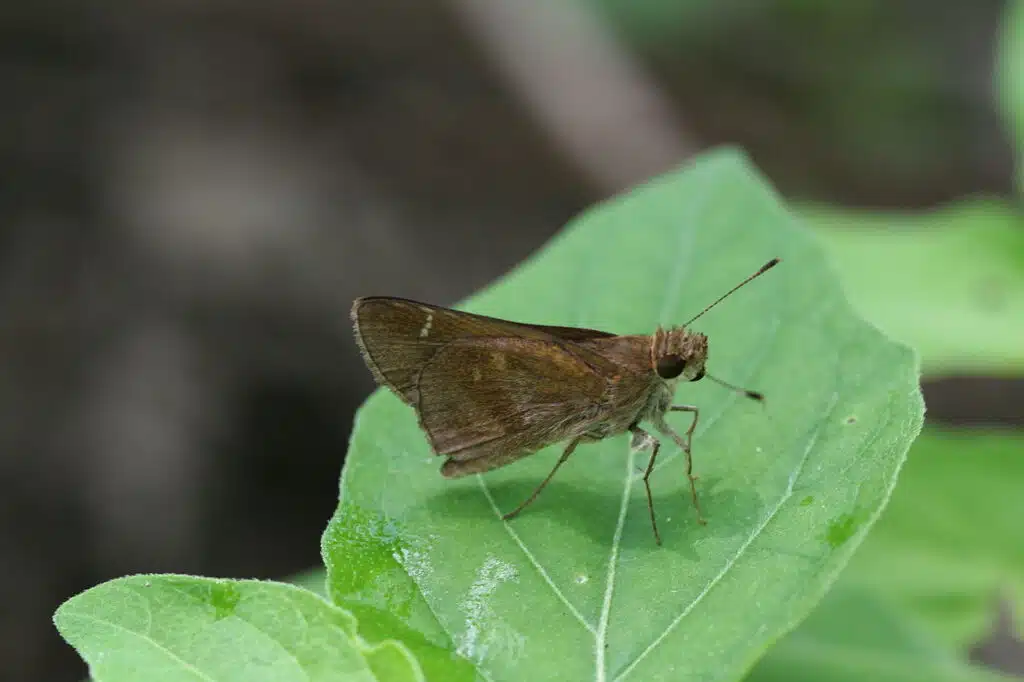
Clouded Skippers (Lerema accius) are seen in Southern Texas. This is where the species lives throughout the year.
You can see Clouded Skippers as one of the species that stands out with its triangular wings.
It can fold its forewings up while its hindwings remain flat.
This species has brown to gray wings with white spots.
Preferred habitats for the Clouded Skipper include woodland edges, marshes, and other open areas.
Clouded Skippers are a species that feeds on many types of flowers for nectar. Shepherd’s needle and buttonbush are just a couple of its favorite flowers.
Adults of this species are seen feeding on a wider range of flowers. They prefer purple and white flowers as opposed to their caterpillars which have other host species.
The Clouded Skipper caterpillar lives and feeds on grasses such as St. Augustine grass.
15. Question Mark

Question Mark butterflies (Polygonia interrogationis) use camouflage to hide in plain sight on tree trunks which they mimic with their ventral wing colors.
The ventral side of their wings is the side they show when sitting on trees. This side is gray and brown, highly similar to the coloring of their host trees.
Question Mark butterflies have orange and brown dorsal wing coloring.
The forewings are mainly orange while the hindwings are black. Black and white margins are specific to both the upper and the lower wings while the body has the molted gray color of the ventral wings.
The species is mostly seen on elm trees such as American elm and Winged elm. Other trees might also be host trees for Question Marks in the absence of suitable elm.
These alternative host trees include hackberries and sugarberries.
Nettles are also host species of Question Marks.
16. Tawny Emperor

Tawny Emperors (Asterocampa clyton) are among the most common Texas butterflies that don’t feed on nectar. These butterflies feed on carrion and dung.
They might rarely consume nectar in the absence of their preferred food sources.
You can identify the species by its mostly orange and yellow wings. Black veins and black margins are specific to this species.
A checkered black pattern and black eyespots are seen on this species.
Brown, gray, and light brown colors are seen on the ventral side of the wings. This side also has eyespots but which are smaller than the dorsal eyespots.
Tawny Emperors are found across the US. These butterflies are adapted to both temperate and tropical climates.
There’s only one Tawny Emperor brood in Northern states. Up to 3 broods are seen in Texas and elsewhere in Florida.
Female adults lay tiny white eggs on host trees such as hackberries.
17. Hackberry Emperor

Hackberry Emperors (Asterocampa celtis) are some of the most common species in Texas that use hackberries as host species.
These butterflies are seen as a major pest of hackberries. Their damage is generally not fatal to trees.
Still, there are many instances where this species consume all leaves of hackberries killing the trees within a few weeks.
The Hackberry Emperor caterpillar is responsible for complete defoliation.
You can identify adult Hackberry Emperors by their orange-brown and dark brown colors.
The lighter colors are situated closer to the body on the dorsal wings while the outer sections of the wings are dark brown to black.
White and black eyespots are seen on the outer side of the wings.
The ventral side of the species is mainly white with larger eyespots. The eyespots on the ventral side are brightly colored and feature double margins.
This species has few natural enemies apart from parasites.
Hackberry Emperor caterpillars are almost completely green which means they benefit from a camouflaging color as they consume green hackberry leaves.
18. Phaon Crescent
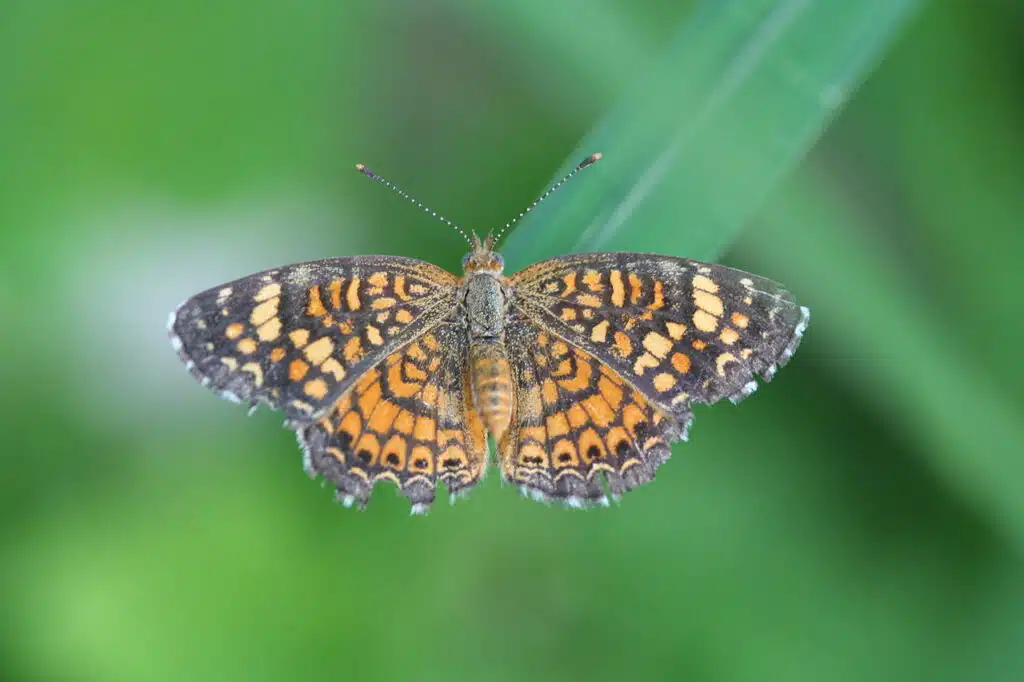
This small species (Phyciodes phaon) is most common in Texas and Florida where it appears in numerous broods per year.
It has a flight season that ends in November elsewhere in the US.
Phaon Crescents are also seen through the years in numerous areas of Mexico and further South in Central America.
This is a small species by wingspan compared to other Texas butterflies.
Orange wings with white and black patterns are characteristic of both the dorsal and ventral sides of the wings.
A checkered black pattern is distinguished on the upper wings. Its lower wings show black veins and wide black margins.
Black eyespots are visible next to the black margins.
Similar colors but with white dominance are seen on the ventral side of the wings.
This species lacks eyespots on the ventral wings.
One of the best places to see this species in Texas is the area rich in shepherd’s needle.
This is the nectar source most preferred by the Phaon Crescent species.
19. Orange Sulphur

Orange Sulphur butterflies (Colias eurytheme) have the main orange color with secondary dark brown colors towards the margins of the dorsal wings.
Orange sections of the wings are closer to its body. This species has a black body.
The ventral side of the Orange Sulphur is almost completely yellow. A few tiny eyespots are seen in this species.
Some exceptions apply in terms of coloring. For example, there’s an albino female Orange Sulphur with a growing US presence.
Orange Sulphur creates havoc among alfalfa and other types of crops.
Their caterpillars are a widespread pest on these crops which can destroy them overnight.
Predatory wasps are used to control the populations of Orange Sulphurs.
This species mates in high numbers on alfalfa crops. A short mating process is also responsible for females laying a large number of eggs.
Males release a type of pheromones that females are attracted to at the beginning of the mating process.
20. Bordered Patch

The Bordered Patch butterfly (Chlosyne lacinia) is black-dominant. This species has mostly black wings with white and orange or red sections.
The upper wings are black with white patches. Hindwings of the species are also black with black bands and orange sections closer to the body.
Bordered Patch butterflies live in various habitats, with a preference for medium elevation and hills.
They are found in woodlands and similar other habitats, even hills in desert areas.
Preferences for a desert climate are seen in the evolution of the species as its caterpillars are mostly tan to light brown.
21. Little Yellow

Little Yellow butterflies (Pyrisitia lisa) are known for their pale yellow color which can sometimes appear as lime-yellow.
As their name implies, these butterflies have a reduced wingspan. This wingspan barely measures more than 1 inch making Little Yellows some of the most common small butterflies in Texas.
This is a migratory species that are only found in Southern Texas whenever it leaves its Eastern US territories for warmer climates.
Its migration mostly occurs Southwards towards Costa Rica.
These butterflies take on the colors of different host plants in the aster genus.
This is why Little Yellow butterflies can be yellow and even white.
Females lay eggs on these host flowers, mainly on the leaves.
Little Yellow caterpillars mostly feed on pea family plants before emerging as adults and moving to asters.
22. Dainty Sulphur

Dainty Sulphur butterflies (Nathalis iole) are mostly yellow. The species has yellow upper wings with black sections towards the edges.
The hindwings of the species are mostly yellow with partial black veins.
2 orange spots are visible on the wings close to the black body.
Underside coloring is also yellow with extra gray sections on the hindwings.
Brown eyespots are further visible on the upper wings.
Dainty Sulphurs are common butterflies in the state. They are seen flying at low altitudes.
Male patrol seeking females all day. Females interesting in a male mate typically spread out their wings.
23. Eastern Tiger Swallowtail
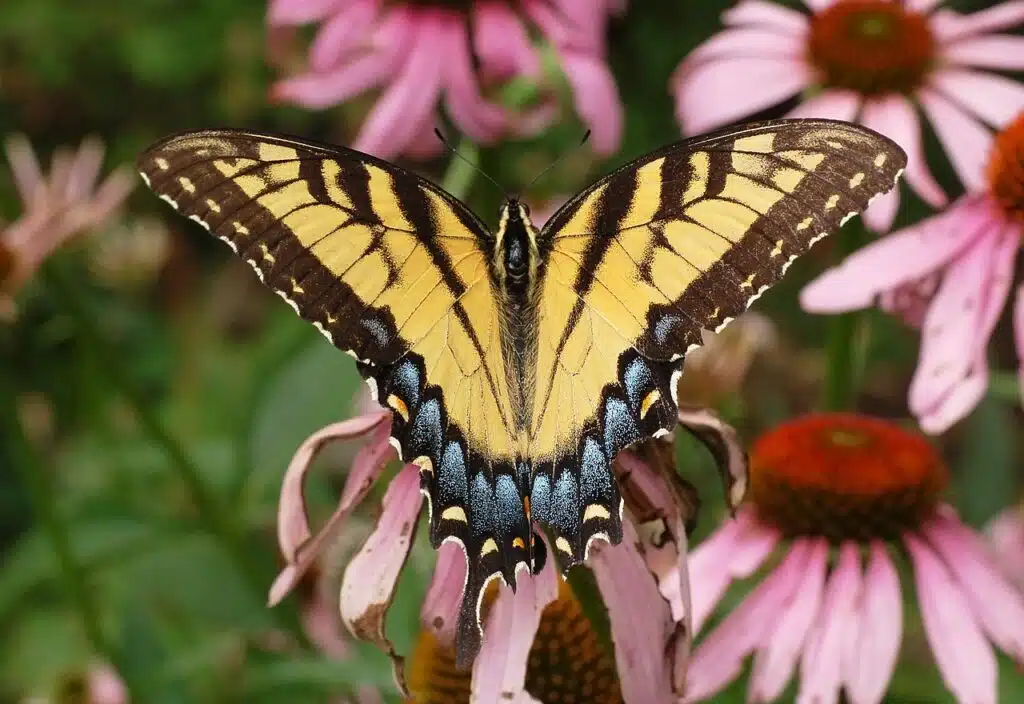
With a wingspan of up to 5.5 inches, the Eastern Tiger Swallowtail (Papilio glaucus) is one of the largest butterflies in Eastern Texas.
This species has black and yellow coloring with a black morph discovered among females.
Male Eastern Tiger Swallowtails have mostly yellow wings with black borders.
Extra black sections are seen on the lower hindwings.
Yellow half-moon marks are further seen on the hindwings.
Small orange spots are visible on the lower hindwings next to the body.
Females have similar coloring with a few differences. The margins are brown instead of black as with males.
The lower hindwings are also blue instead of black-dominants as with male Eastern Tiger Swallowtails.
Rare morphs of the female have also been discovered in the state.
This morph has a black-dominant color. The upper wings are completely black while the hindwings are black with some blue areas and just 5 yellow half-moon marks along the margins.
Similar smaller yellow dots are seen on the margins of the upper wings on the black morph of the Eastern Tiger Swallowtail.
The underside of this morph is also black which helps the female remain undetected/
24. Painted Lady
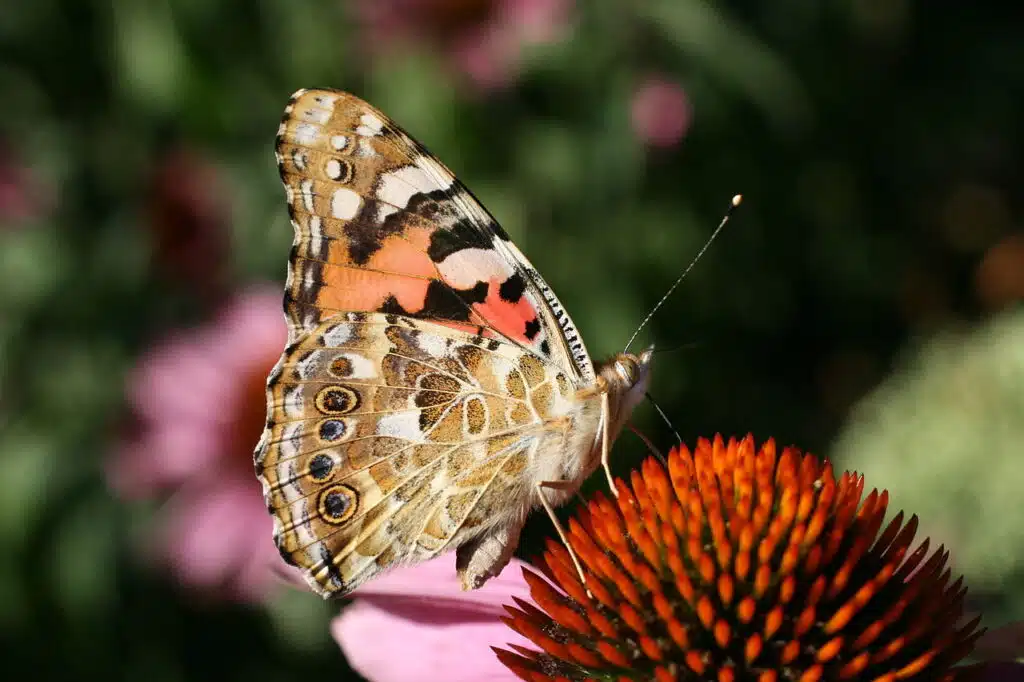
Painted Lady butterflies (Vanessa cardui) are common across North America and Europe.
The species is one of the most common migratory species in the world. The longest Painted Lady migration takes place from Northern Africa to Europe with shorter migration specific to North America.
The species is not present in South America.
Painted Lady butterflies are identified by a colorful orange, black, brown, and white body.
Orange coloring covers almost the entire area of the wings with black seen mostly on the margins of the upper wings.
Black checkered patterns are further visible on the hindwings.
White dots and marks are seen only on the upper wings.
The species has white, brown, and dark brown ventral wings.
Eyespots are also distinguished on this side of the wings. Blue, yellow, and black eyespots are seen on the ventral wings.
25. Reakirt’s Blue

With a wingspan of up to 23mm, this is one of the smallest migrating butterflies in Texas.
Rearkirt’s Blue (Echinargus isola) is a species that moves to Southern Texas and Mexico to escape cold weather in the Northern states.
These small butterflies are seen in a vast area of the United States up to Southern parts of Canada.
When they arrive in Texas, the butterflies prefer the extreme Southern regions of the state.
Gardens and crops are typical areas where these butterflies settle.
The presence of herbs is what attracts them the most. Spearmint herbs are among the favorite sources of food for Reakirt’s Blue.
These butterflies can be identified by a gray-brown body with white sections and black eyespots.
Some of the most visible eyespots in the species are located on the outer ventral wings.
26. Sachem
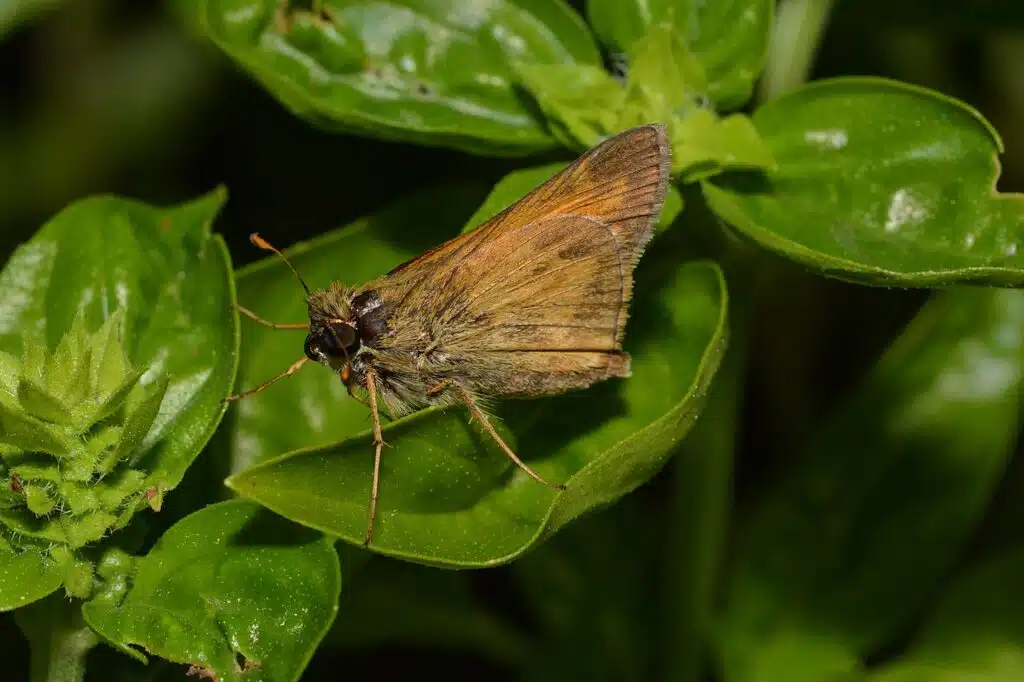
The Sachem species (Atalopedes campestris) is mostly native to tropical areas and partly to temperate areas of the US.
Butterflies of the Sachem genus move North in the summer, in a collective migration process.
These butterflies are native to Texas, Central America, and Northern parts of South America.
Northern expansion of the species has been noted over the past few decades. This is mostly achieved by migrating populations that establish themselves North of Texas.
Most Sachem butterfly populations in Texas do not migrate. They are seen in the state throughout the year. Other Sachem butterflies arrive in Texas and further South from Northern territories.
Yellow, gray, and brown are the main colors of the Sachem male.
This species has a gray-blue body and yellow wings with dark brown margins.
Sachem butterflies are among the few species in Texas that have triangular-shaped wings. They can fold their upper wings upwards.
27. Sleepy Orange
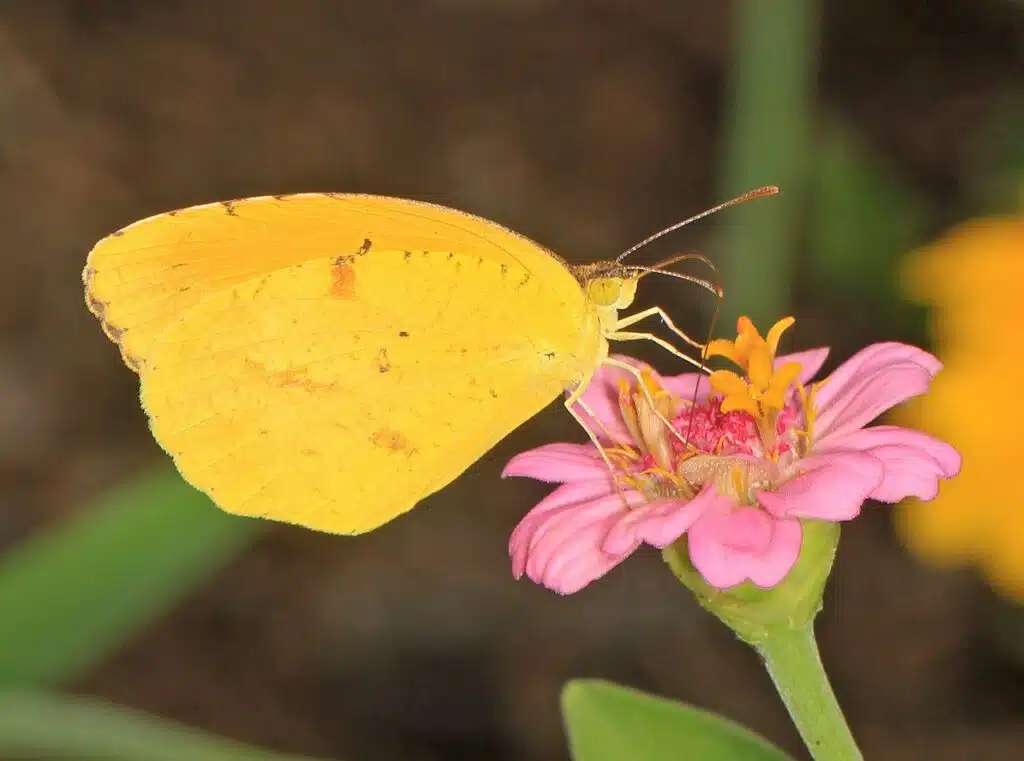
Sleepy Orange butterflies (Abaeis nicippe) get their name from their orange-dominating color. Their wings are mostly orange.
Brown or black margins are specific to these butterflies.
The underside of the species is mostly yellow. Butterflies of this genus mostly appear yellow when stationary.
Feeding on various plants, these butterflies are among the puddling species of Texas.
This means males often congregate next to mud sources where they extract moisture and nutrients.
Often visible on woodlands edges, these butterflies live solitary lives but they get together in mud areas with puddling water for feeding.
It’s only the male Sleepy Orange butterflies that feed on mud as females prefer to only feed on pea family plants.
28. Cloudless Sulphur
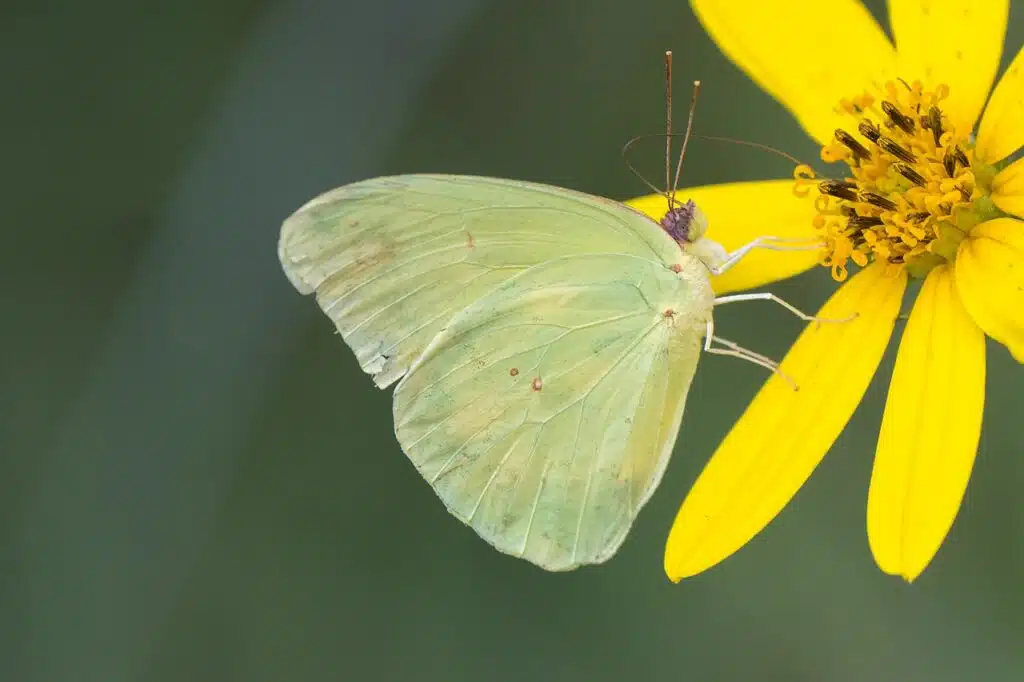
Also, a species that uses pea plants as host species, Cloudless Sulphurs (Phoebis sennae) are very similar to Monarchs in their migratory habits.
Cloudless Sulphur butterflies come to Texas to overwinter in warmer climates.
They make this Southwards journey even from areas with abundant food as they cannot survive cold winters in the North.
Adults head back to the North to breed in the spring.
Cloudless Sulphur butterflies are mostly yellow or yellow-green.
They have a black upper body and a yellow lower body. Tiny black or orange-red marks can be distinguished on the wings of males and females.
Caterpillars of the Cloudless Sulphur species only partially resemble adults in their late instar when they’re also dominantly yellow.
29. Checkered White

Checkered White butterflies (Pontia protodice) are minor pests on Texas crops. The caterpillars of the species live on cabbage and broccoli.
This species has a white-dominant color into adulthood. Just a few faded black marks are distinguished on its body.
Checkered White butterflies have a black body.
This species is a minor migratory butterfly in Texas. However, migration isn’t always a yearly habit within this species.
Only female Checkered White butterflies migrate individually or in small groups.
It’s the overpopulation of a certain area that prompts female Checkered White butterflies to seek out other unexplored areas.
Males may follow but in lesser numbers.
Mated females might also migrate seeking the perfect host plant to lay eggs on. Short migrations within mated females are also common.
You can distinguish female butterflies from males by the gray marks instead of black marks across the wings.
30. Eastern Giant Swallowtail

Eastern Giant Swallowtails (Papilio cresphontes) are some of the largest butterflies in Texas. This species has a wingspan that can reach 5.5 inches but most butterflies measure around 4.5 inches.
The long wingspan of the Eastern Giant Swallowtail also makes it one of the top fliers in the state, even on windy days.
You can identify the Eastern Giant Swallowtail by its black and yellow wings.
Most of the wings are black covered in a yellow band on the lower upper wings and in yellow marks across the margins.
Yellow and black coloring is also specific to the ventral side of the wings.
Small red marks are visible on the lower side of the wings close to the black body.
Adult Eastern Giant Swallowtail butterflies feed on plant nectar and dung. Lantana and azalea flowering plants are among their favorite sources of nectar.